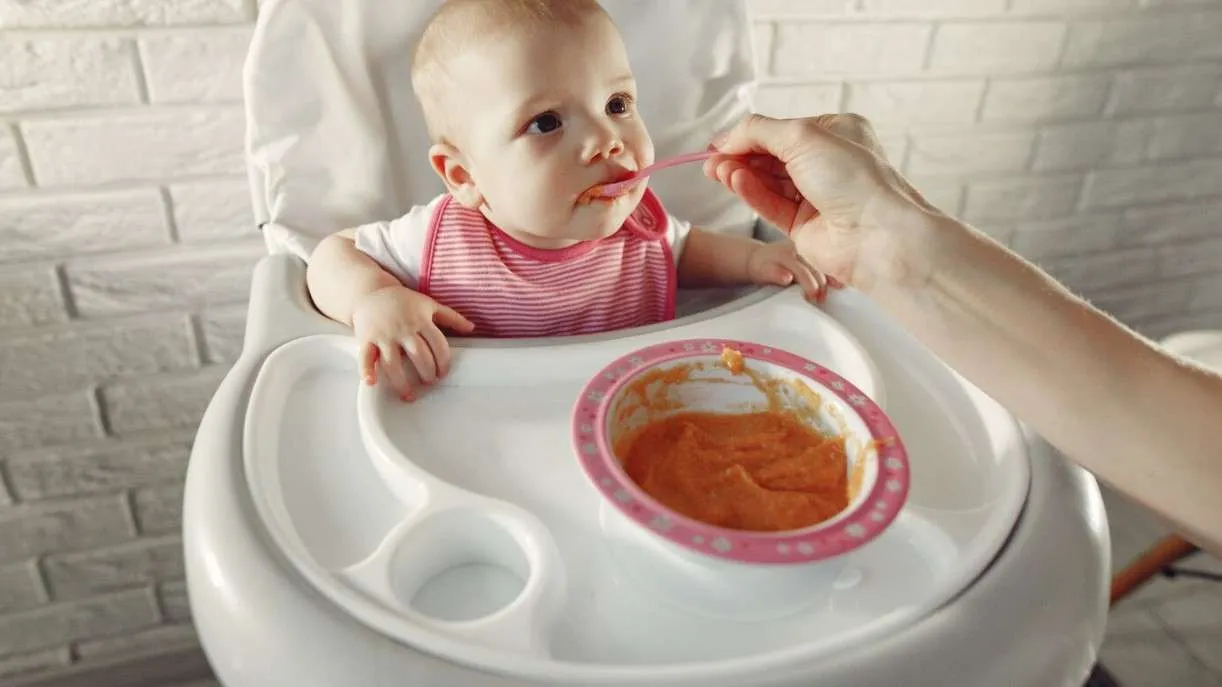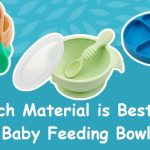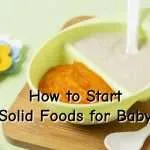Around 6 months of age marks an exciting milestone as you start introducing solid foods to your baby’s diet. Using the 6 months baby food chart as a guide can help ensure your little one gets the nutrition they need as you expand and enrich their diet.
This comprehensive article covers everything parents need to know about feeding a 6 month old baby, from understanding developmental readiness, starting solids safely, making homemade purees, key nutrients to focus on, sample schedules, troubleshooting issues, and more. With the detailed 6 months baby food chart breakdown and age appropriate feeding tips provided here, you’ll feel confident feeding your 6 month old nourishing foods while following their cues.
Key Takeaways
- Start solids at 6 months when baby can sit up, hold head steady, close lips on spoon
- Introduce purees 1 at a time: rice cereal, fruits, vegetables, meats
- Focus on iron, zinc and protein rich foods like cereals, meats, dairy
- Make own purees by blending/mashing fruits, vegetables, meats
- Feed smooth purees first, progress texture to mashed foods
- Let baby set the pace – watch for hunger/fullness cues
- Allergies: go slow, watch for reactions to new foods
- Consult pediatrician if concerns about nutrition, growth, feeding skills
Signs of Readiness at 6 Months
The American Academy of Pediatrics recommends introducing solid foods around 6 months of age once a baby can:
- Sit up partially with support
- Hold their head steady
- Close lips around spoon to swallow food
- Show interest in foods you’re eating
Baby’s digestive system also matures around this time to handle more complex foods. Don’t feel pressure to start exactly at 6 months – look for the signs of readiness. Early introduction before 4 months increases chances of allergies and obesity. Wait for cues baby is developmentally ready.
Discuss starting solids at your baby’s 6 month well visit. Your pediatrician can help determine if baby is ready based on growth and milestones. Have a plan for what foods you’ll introduce and how you’ll do so safely.
Starting Solids Safely
When first embarking on feeding solids, keep these safety tips in mind:
- Go slow – start with just a few teaspoons daily
- Only introduce one new food at a time
- Choose single ingredient foods at first to identify allergies
- Always supervise closely, especially with chunkier textures
- Do not give foods that present choking hazards like whole grapes, hot dogs, nuts, etc.
- Never put solids in a bottle – risk of overfeeding or aspiration
- Respond to hunger/fullness cues – don’t overfeed
- Avoid added salt, sugars, unhealthy fats
- Prepare foods appropriately – steam, boil, bake, puree
Talk to your pediatrician about vitamin supplements like iron or fluoride. Breast milk or formula should still be the main source of nutrition at this stage. Introduce solids slowly and follow baby’s lead.
First Foods to Try
When first embarking on solid foods around 6 months, here are some great starter options:
- Iron-fortified rice cereal – Mix with breastmilk or formula. Provides iron.
- Pureed fruits and vegetables – Try pear, apple, sweet potato, carrots, peas. Full of vitamins.
- Banana – Mash and mix with breastmilk. Easy to digest starch.
- Avocado – Loaded with healthy fats and potassium. Mash or puree.
- Plain yogurt – Provides protein. Whole milk yogurt best.
- Pureed meat – Iron source. Chicken, turkey, beef. Well-cooked and pureed.
- Beans/legumes – Mash and puree beans, lentils, chickpeas. Excellent protein.
- Eggs – Scramble egg yolks well. Important protein.
Stick to single ingredient foods at first to check for allergies or sensitivities. Give 2-3 days before introducing another new food. Respond to baby’s likes and dislikes.
Making Your Own Purees
Making your own baby food allows you to control the ingredients and flavors. Here are some tips:
- Steam/boil veggies until very soft then puree with breastmilk or water
- Bake/boil fruits, remove skins, seeds – puree with breastmilk or water
- Puree well-cooked plain meats and fish into a smooth texture
- Mash bananas, avocados, beans by hand or use a food processor
- Freeze 1-2oz portions in ice cube trays for later convenience
- Store homemade purees in fridge for 2-3 days or freezer for 2-3 months
- As baby adjusts, gradually make purees thicker or mash/chop foods
- Season plain purees with cinnamon, nutmeg, parsley – no salt or sugar
Homemade baby food provides flexibility to tailor textures and flavors to your infant. Introducing purees made from family meals helps baby adjust to flavors.
Sample Feeding Schedule
Here is a sample schedule for feeding a 6 month old:
Breakfast: Rice cereal mixed with breastmilk/formula + mashed fruit
Lunch: Pureed veggies and protein like chicken or beans
Dinner: Avocado/banana mash and plain yogurt
Snacks: Mum mum rice snack, pureed prunes/peaches
Beverages: Breastmilk or formula, offer sips of water
Around 6 months, babies still get most nutrition from breast milk or formula – aim for 32+ oz per day. Slowly build up to 3 solid “meals” per day plus snacks. Respond to hunger cues – may start on just 1-2 “meals” daily. Introduce one new food every 2-3 days watching for reactions.
Troubleshooting Common Issues
Some common feeding issues that may come up around 6 months:
- Constipation – Offer pear, prune, peas. Check with pediatrician before giving water.
- Gas – Limit fruit, offer probiotic yogurt, bicycles legs. Burp frequently during/after feeding.
- Reflux – Smaller/more frequent feeds. Hold upright 20+ mins after eating. Consult pediatrician.
- Allergy – Watch for rash, nausea, wheezing. Stop food and call doctor.
- Choking – Take infant CPR class! Learn the signs and how to clear airway.
- Food refusal – Keep offering rejected foods. Vary textures/temps – may take 10+ tries over weeks!
Be patient and responsive as you introduce solids. Call your pediatrician if you have concerns about nutrition, allergies, growth patterns or developmental readiness for feeding.
Conclusion of 6 Months Baby Food Chart
Around 6 months of age, the baby food chart indicates it is time to start introducing solid foods as baby shows key signs of readiness. Use iron-fortified cereals, pureed fruits and vegetables as first foods, making your own baby food from family meals. Feed smooth purees at first, gradually increasing texture. Let your infant set the pace, following hunger/fullness cues. Allergies are a concern, so go slow with new foods. Make the transition joyful and talk to your pediatrician if issues arise. Trust yourself – you’ve got this!
Frequently Asked Questions
What consistency should first foods be at 6 months?
Start with smooth, thin purees and gradually thicken. Around 6 months, babies do well with a puree with a yogurt-like consistency.
How many meals per day for a 6 month old?
Start with 1-2 “meals” of solids per day at first, slowly building up to 3 “meals” and 2 snacks around 6-8 months old. Keep offering breastmilk or formula on demand.
Can I put cereal in my 6 month old’s bottle?
No, do not put any solids in bottles until baby is used to eating solids from a spoon, around 8 months old. Can risk overfeeding or aspiration before then.
What can I do if my baby doesn’t seem interested in solids?
Keep offering different pureed fruits and veggies. Try different textures and temperatures. Model eating. Consult pediatrician if still refusing solids after a month of trying.
How do I know if baby is ready for chunkier textures around 6 months?
Signs baby is ready for mashed or chopped textures are chewing motions, grabbing food, lifting tongue to reach food, and swallowing thicker purees without difficulty.
Can I give my 6 month old yogurt drops or puffs?
Occasional yogurt melts and puffs are OK but stick to purees as primary solids. Avoid added sugars. Can cause choking if swallowing skills aren’t developed.









